 Last additions Last additions |
|
|

"Golden waves on which we weave..."Mar 13, 2007
|
|

"Tell us my friends your stories, with your fervent hearts."Mar 13, 2007
|
|

Golden wavesMar 13, 2007
|
|

Stone monument for Verse 6Mar 13, 2007
|
|

Chomeiji worships the Kannon goddess of long life and good health. "Chomeiji" literally means "Long Life Temple." See more photos of Chomeiji Temple here.Mar 13, 2007
|
|

Regatta on Lake BiwaMar 13, 2007
|
|

Chomeiji, 31st temple on the Saigoku Pilgrimage CircuitMar 13, 2007
|
|
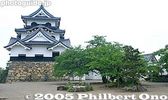
More photos of Hikone Castle here.The castle tower is a National Treasure. Hikone Castle is one of only five castle towers in Japan designated as National Treasures. (The others being Himeji, Inuyama, Matsumoto, and Matsue Castles. Nijo Castle in Kyoto is also a National Treasure, but it does not have a castle tower.)
See more photos of Hikone Castle here.Mar 13, 2007
|
|

"Dispel this world's impureness, very faraway."Mar 13, 2007
|
|

"Saigoku pilgrimage, Chomeiji."Mar 13, 2007
|
|
|

"Abundant summer grasses, a moat still remains"Mar 13, 2007
|
|

Verse 5 Lyrics (Hikone) 五番の英訳(彦根)Sharp arrows buried deeply, way into the ground.
Abundant summer grasses, a moat still remains.
Standing in an old castle, all alone oneself.
Hira and Ibuki too, only but a dream.
矢の根は 深く埋もれて
夏草しげき 堀のあと
古城にひとり 佇めば
比良も伊吹も 夢のごと
Ya no ne wa, fukaku uzumorete
Natsukusa shigeki, hori no ato
Kojo ni hitori, tatazumeba
Hira mo Ibuki mo, yume no goto
--
This is the only verse where the setting is not specifically mentioned. The only hint is "old castle," which must be either Nagahama Castle or Hikone Castle. It is likely that it is Hikone Castle with its authentic castle tower and moats.
See more photos of Hikone here.Mar 13, 2007
|
|

Verse 6 Lyrics (Chomeiji) 六番の英訳(長命寺)Saigoku pilgrimage, Chomeiji.
Dispel this world's impureness, very faraway.
Golden waves on which we weave, rowing all we can.
Tell us my friends your stories, with your fervent hearts.
西国十番 長命寺
汚れの現世 遠く去りて
黄金の波に いざ漕がん
語れ我が友 熱き心
Saigoku Juban, Chomeiji
Kegare no utsushiyo, tooku sarite
Kogane no nami ni, iza kogan
Katare wagatomo, atsuki kokoro
--
This verse is said to refer to the Pure Land of Buddhism. The song has strong Buddhist overtones, but interestingly the melody happens to be based on a Christian hymn. Chomeiji was a lunch stop before they rowed back to Otsu.
See more photos of Chomeiji Temple here.Mar 13, 2007
|
|
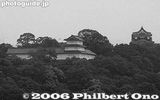
Hikone CastleMar 13, 2007
|
|

Buddha statue on ChikubushimaMar 13, 2007
|
|

"Azure blue flower garden, revered coral shrine."Mar 13, 2007
|
|

"Full of old-time stories, Chikubushima."The island has a complex of temples named Hogonji. It belongs to the Shingon Buddhist Sect (Buzan School). It is said that it was first built in 724. It is also the 30th temple in the 33 Temple Pilgrimage of Saigoku (Western Japan).
See more photos of Chikubushima here.Mar 13, 2007
|
|
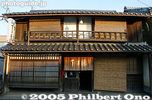
Chojiya ryokan inn, Imazu. This is probably the inn where Taro Oguchi and crew stayed in Imazu and created the song in 1917. 丁子屋It is along the lake shore and still in business today.
It was on June 28, 1917 in Imazu, after dinner on the second day of their rowing trip, when a boatmate named Jiro Nakayasu exclaimed, "Hey everyone, listen up! Oguchi has written this song," and showed everyone the song. Then another boatmate named Taniguchi, who knew a popular song called Hitsuji Kusa (Water Lilies), began singing Oguchi's lyrics to the melody. Since the melody went well with the words, the seven boat crewmates sang the song together that night. It was the birth of the Lake Biwa Rowing Song. The boys worked on the song further and sang it while rowing.
See more photos of Imazu here.Mar 13, 2007
|
|

Broken dishes near the toriiMar 13, 2007
|
|
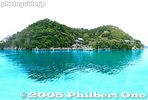
Verse 4 Lyrics (Chikubushima) 四番の英訳(竹生島)Azure blue flower garden, revered coral shrine.
Full of old-time stories, Chikubushima.
In the hands of Buddha, one young maiden lies.
She's sleeping in compassion, resting peacefully.
瑠璃の花園 珊瑚の宮
古い伝えの 竹生島
仏の御手に いだかれて
ねむれ乙女子 やすらけく
Ruri no hanazono, sango no miya
Furui tsutae no, Chikubujima
Hotoke no mite ni, idakarete
Nemure otomego, yasurakeku
Lake Biwa's most famous and sacred island is accessible by boat from Hikone, Nagahama, and Imazu. Color of the water in the photo is not real.Mar 13, 2007
|
|

Nagahama Castle as seen from Lake Biwa. More photos of Nagahama here.The castle tower was reconstructed in 1984.
More photos of Nagahama here.Mar 13, 2007
|
|

Chikubushima as seen from ImazuMar 13, 2007
|
|

Peninsula where Oguchi Taro and crew departed Imazu. On this peninsula at Imazu, Taro Oguchi and crew departed in their boat for Chikubushima island. The large building is a boathouse that stores two reconstructed fixed-seat boats.Mar 13, 2007
|
|

Lake waters of Imazu, with Chikubushima and Mt. Ibuki in the distance.Mar 13, 2007
|
|

Lake shore at ImazuMar 13, 2007
|
|

The large boat house houses two reconstructed fixed-seat boats. This is where Oguchi and crew departed Imazu for Chikubushima.Mar 13, 2007
|
|

"On shore we see red fire, brings back memories." (Imazu)This is the lake beach at Imazu.
See more photos of Imazu here.Mar 13, 2007
|
|

"On shore, we see red fire"Imazu was where the song was born. The town has two monuments for the song. One is the lamp monument built in 1985 on the boat pier (top photo) for Verse 3 (written on the lamp post), and the other is a red stone monument in the shape of a fire dedicated to the entire song. The lamp monument lights up in red at night. The above image was digitally altered.Mar 13, 2007
|
|

Omatsu "Famous Place" markerMar 13, 2007
|
|

Pine trees at Omi-MaikoMar 13, 2007
|
|

Ripples lap white sands of Omi-Maiko.Mar 13, 2007
|
|

White sands of Omi-Maiko (Omatsu), Otsu, ShigaMar 13, 2007
|
|

"Pine trees are very green, on sands very white." Omi-MaikoMar 13, 2007
|
|

Verse 2 Lyrics (Omatsu/Omi-Maiko) 二番の英訳(雄松"Pine trees are very green, on sands very white.
Omatsugasato is, a young maiden's home.
Bush of red camellia, hides her teary face.
She's weeping o'er a lost love, much too short to last.
松は緑に 砂白き
雄松が里の 乙女子は
赤い椿の 森蔭に
はかない恋に 泣くとかや
Matsu wa midori ni, suna shiroki
Omatsugasato no, otomego wa
Akai tsubaki no, morikage ni
Hakanai koi ni, naku toka ya
Omi-Maiko is still famous for white sand beaches and pine trees. In summer these beaches are cluttered with people trying to get a tan.
See more photos of Omi-Maiko here.Mar 13, 2007
|
|

"Rising mist evaporates, ripples come and go." のぼる狭霧や さざなみのMar 13, 2007
|
|

Rear of boat house, now used by a private boat club.Mar 13, 2007
|
|

Reeds bid rowers farewell for now...Mar 13, 2007
|
|

Mihogasaki harbor, Otsu. The arrow points to the boat house where Oguchi Taro and crew departed for their rowing trips.Mihogasaki is accessible by bus from Otsu Station. Or just walk west from Hama-Otsu. This is also where water from the lake is drawn into the Biwako Canal's first canal which feeds water to Kyoto.Mar 13, 2007
|
|

Boat house where Taro Oguchi and crew departed on their rowing trip. No longer used by the university's boat club. Mihogasaki, OtsuMar 13, 2007
|
|
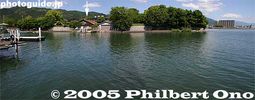
Mihogasaki harbor, Otsu. The arrow points to the boat house.Mar 13, 2007
|
|

"Umi no Ko" (Child of the Lake) Lake Biwa training boat for kidsMar 13, 2007
|
|

"Umi no Ko" (Child of the Lake) Lake Biwa training boatThe bow of Shiga Prefecture's "floating school." The name of this boat was obviously taken from the song. The boat is owned by Shiga Prefecture and used to educate elementary school kids about the lake. Since 1983, this ship has been serving as a floating school for kids where they stay overnight and spend two days conducting experiments to learn more about the lake. Picture was taken at Hikone Port.Mar 13, 2007
|
|

About the song and rowing route... この歌について(日本語解説)Shiga Prefecture's most famous and beloved song is called Biwako Shuko no Uta (琵琶湖周航の歌) or "Lake Biwa Rowing Song." I have rendered this song into both pictures and English, according to my own imagination and interpretation.
Please see this page for a full explanation: https://photoguide.jp/txt/Lake_Biwa_Rowing_Song
First composed in 1917 by a bunch of college students from Kyoto, the song has been recorded by many famous Japanese singers and groups. In 1971, it became a major nationwide hit with singer Tokiko Kato's rendition. Today, the song remains a favorite among choir groups in Japan, and a choir singing contest is held for the song every June (since 1997) in Imazu, the birthplace of the song in the northwestern corner of Lake Biwa.
Shiga Prefecture also has stone monuments dedicated to each of the six verses. There's even a museum (Biwako Shuko no Uta Shiryokan) in Imazu dedicated to the song. Okaya city on the shores of Lake Suwa in Nagano Prefecture, the birthplace of the song's composer, Taro Oguchi (小口太郎) (1897-1924), also has a song monument and bronze statue of him.
Mar 13, 2007
|
|

The photo above shows part of the stone monument for the first verse of the song. It reads "Ware wa Umi no Ko" (We're children of the lake). [url=http://photoguide.jp/txt/Lake_Biwa_Rowing_Song]More info about Lake Biwa Rowing Song here.[/uThis is the song's first and most famous line. The monument is in a small park near the former boathouse in Mihogasaki pier. The photo has been digitally altered (the colors are not real).
I visited and photographed all the places mentioned in the song as well as all the song monuments in Otsu, Omi-Maiko, Imazu, Chikubushima, Hikone, Chomeiji, and Okaya (Nagano). I also created some digital images to match the scenes mentioned in the song.Mar 13, 2007
|
|

Printable map and directions to all song monuments. Google map 歌碑の案内地図Also see this Google map: Google mapMar 10, 2007
|
|
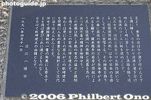
Message plaque, Verse 6 Song Monument, ChomeijiMar 10, 2007
|
|

Rear of Verse 6 monument. Next to the main stone is a plaque for the entire lyrics.Mar 10, 2007
|
|

Plaque for entire lyrics, Verse 6 Song Monument, ChomeijiJapanese lyrics of the entire song consisting of 6 verses.Mar 10, 2007
|
|

Verse 6 Song Monument, Chomeiji Port. Built in 1998. 六番の歌碑。長命寺(バス停のすぐそば)Near the Chomeiji bus stop. It faces the pier. This monument has the most number of stones. But only two of them are used.
See more photos of Chomeiji Temple here.Mar 10, 2007
|
|

Kyoto University Rowing Club visit the Verse 6 monument during their during their annual Lake Biwa rowing trip. 写真/尾城徹雄Chomeiji is one of their overnight stops during their 3-day rowing trip. Mar 10, 2007
|
|

Close-up of main stone monument where Verse 5 is written. 2005年10月に除幕されて一番新しい歌碑。800万円の寄付金で建てた。Sharp arrows buried deeply, way into the ground.
Abundant summer grasses, a moat still remains.
Standing in an old castle, all alone oneself.
Hira and Ibuki too, only but a dream.
Ya no ne wa, fukaku uzumorete
Natsukusa shigeki, hori no ato
Kojo ni hitori, tatazumeba
Hira mo Ibuki mo, yume no goto
矢の根は 深く埋もれて
夏草しげき 堀のあと
古城にひとり 佇めば
比良も伊吹も 夢のごとMar 10, 2007
|
|

Verse 5 Song Monument, Hikone Port 五番の歌碑。彦根港The left stone is inscribed with the entire song, and bigger stone on the right has the lyrics for verse 5. There is also another stone which shows a map of the lake and rowing route. The monument is now encroached by tall grass and weeds.
This song monument was built in Oct. 2005 at a cost of 8 million yen (gathered through donations). With this, now all six verses each have a song monument. This one is next to Hikone Port where you board the boat to visit Chikubushima or Takeshima.Mar 10, 2007
|
|

Biography of Oguchi TaroMar 10, 2007
|
|

The first verse is wriiten, but the first line about Chomeiji being the 10th temple in the Saigoku Pilgrimage is omitted.Chomeiji is the 31st temple in the Saigoku Pilgrimage, not the 10th temple as sung in the song.Mar 10, 2007
|
|

Verse 6 Song Monument facing Chomeiji pierMar 10, 2007
|
|

Verse 5 Song Monument facing Hikone Port. See more photos of Hikone here.The three-stone monument is in a good location facing Hikone Port. This photo was taken soon after the monument was built. Over the years, wild grass or weeds have invaded the monument plot.
Mar 10, 2007
|
|
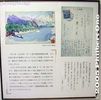
Handpainted postcard from Taro Oguchi mailed from Imazu on June 28, 1917.During the rowing trip, Oguchi wrote a postcard to a friend back at the school dorm in Kyoto. One side of the card has his watercolor painting of Omatsu with pine trees on the sandy beach and a boat pier. Oguchi was quite good at painting.
Oguchi sent the postcard from Imazu on June 28, 1917, in the evening sometime between 9 pm and midnight after arriving from Omatsu. He sent it to a friend named Hiroshi Kodama back at the school dorm in Kyoto. However, the friend never received the postcard since he was back in his hometown in Niigata Prefecture for the summer.
The postcard was returned to Oguchi who kept it. If his friend had received the postcard, he would have certainly thrown it away (as he later mentioned in an interview). This postcard has survived miraculously and it is key evidence for the exact date when they were in Imazu where the song was created.
On the postcard, Oguchi writes about how easy it was to row to Omatsu the day before, thanks to a strong tailwind. He notes that Omatsu was a lonely place with only one lodge. They tied up the boat in the pond and rolled around on the sand till late night while gazing at the moon and dreaming of a beautiful girl. That morning, they played tug of war (it was fun). He also mentions that they were to lodge in Imazu that night.Mar 10, 2007
|
|

Main stone of Verse 6 Monument 問題の「西国十番」が刻んでいない。Saigoku pilgrimage, Chomeiji.
Dispel this world's impureness, very faraway.
Golden waves on which we weave, rowing all we can.
Tell us my friends your stories, with your fervent hearts.
Saigoku Juban, Chomeiji
Kegare no utsushiyo, tooku sarite
Kogane no nami ni, iza kogan
Katare wagatomo, atsuki kokoro
西国十番 長命寺
汚れの現世 遠く去りて
黄金の波に いざ漕がん
語れ我が友 熱き心Mar 10, 2007
|
|

Verse 5 Song Monument, the third monument showing the rowing route, Hikone PortThe monument's third stone shows a map of the lake and rowing route. It also states the dates when all the song monuments were built in Shiga.
See more photos of Hikone here.Mar 10, 2007
|
|

Biwako Shuko no Uta Shiryokan (Lake Biwa Rowing Song Museum), Imazu 琵琶湖周航の歌資料館Mar 10, 2007
|
|

Chikubushima boat dock. The Verse 4 Song Monument on can be seen on the left.Mar 10, 2007
|
|

Model of fixed-seat boat used during Oguchi Taro's time in 1917.Model of the fixed seat boat that Taro Oguchi and crew used to row around Lake Biwa. Displayed at the song museum in Imazu. The boat is quite stable and thus suited for long rowing trips. However, it became obsolete in the 1960s as competitive rowing boats incorporated sliding seats.
In 1993, a boat craftsman built two of these and donated them to Imazu. They measure 13.7 meters long and 1.25 meter wide. Seats 6 crew. They are available for rent at Imazu.Mar 10, 2007
|
|

Panel showing Japanese lyrics, old and new. Biwako Shuko no Uta Shiryokan, ImazuOne of the exhibition panels with the song lyrics showing all the little quirks and idiosyncrasies of the words. This is the first verse.Mar 10, 2007
|
|
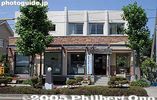
The old Biwako Shuko no Uta Shiryokan (Lake Biwa Rowing Song Museum), Imazu 琵琶湖周航の歌資料館、今津町This museum dedicated to this song opened in April 1998 in Imazu. It is a 3-min. walk from Omi-Imazu Station on the JR Kosei Line. Closed in March 2020 and moved to a new building.
Hours: 9 am to 5 pm, closed Mon. (open if Mon. is a national holiday, and closed on Tue. instead)
Free admission.Mar 10, 2007
|
|

Model of fixed-seat boatMar 10, 2007
|
|
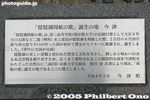
Song Monument plaque, Imazu. It explains about how the song was created in Imazu.Mar 10, 2007
|
|

Chikubushima island and snowly Mt. Ibuki in the background.Mar 10, 2007
|
|

Model of fixed-seat boat, Biwako Shuko no Uta Shiryokan museumMar 10, 2007
|
|

Song monument at Imazu Port.Mar 10, 2007
|
|

Imazu Port and song monument in winter snow.Mar 10, 2007
|
|

Old Imazu Port. Notice the "red flame" song monument on the right.Mar 10, 2007
|
|

Verse 3 Song Monument is written with Verse 3.We drift from wave to wave, straying aimlessly.
On shore we see red fire, brings back memories.
With our sights set nowhere, rolling with the waves.
Today is Imazu or, Nagahama huh.
Nami no mani mani, tadayoeba
Akai tomaribi, natsukashimi
Yukue sadamenu, nami makura
Kyo wa Imazu ka, Nagahama ka
浪のまにまに 漂えば
赤い泊火 懐かしみ
行方定めぬ 浪枕
今日は今津か 長浜か Mar 10, 2007
|
|

Biwako Shuko no Uta Birthplace Monument, Imazu. This is Imazu's second monument for the song. 全歌詞碑の「琵琶湖周航の歌」誕生の地 今津。今津港。背景には竹生島行きの船。Imazu has two monuments for the song. The first one is a lamp at the end of the pier (visible in this picture on the right of the boat). That was for Verse 3 which is written on the lamp post.
Later in 1994, Imazu town built this red clay monument to commemorate the song's birth in Imazu. The entire lyrics is also engraved. It is next to the Imazu boat pier where boats depart for Chikubushima. Looks like a red flame, but it's shaped after the geographical shape of Imazu town.
From Imazu, you can easily go to Chikubushima island, from which you can take another boat to go to Hikone or Nagahama. Going vice versa is possible too. It's a great way to cross the lake.
See more photos of Imazu here.Mar 10, 2007
|
|

Song Monument, Imazu. Looks like red fire, but it's also the shape of Imazu town. (The background shows the old Imazu Port building.)Directions: From Omi-Imazu Station on the JR Kosei Line, get out the east exit and walk on the main road toward the lake. You will soon see the Biwako Shuko no Uta Shiryokan song museum on the left. Be sure to visit this museum too. Walk further toward the lake and you will see Imazu Port. Near the water, you can see the "red fire" song monument. On the very end of the pier, and you can see the lamp monument. (The pier might be closed off if there is no boat, so you may have to ask permission to walk on the pier.) Omi-Imazu Station also has a tourist information office where you can obtain directions and a map.Mar 10, 2007
|
|

Imazu Port. Verse 3 Song Monument is at the end of the dock. The same dock used by boats going to Chikubushima. The dock is usually closed.Chikubushima island and Mt. Ibuki can be seen.Mar 10, 2007
|
|

Verse 3 Song Monument Mar 10, 2007
|
|

Old photo of Verse 2 Song Monument in Omi-Maiko. The tree was cut down and lyrics later painted white.Mar 10, 2007
|
|

Near the Verse 1 Song Monument is another stone monument engraved with the words of the entire song.Mar 10, 2007
|
|

Small park where the Verse 1 monument is located.This monument is near the boat house in Mihogasaki, a stone's throw from Hama-Otsu. It was built in 1973 as the first monument for the song.
This little park is actually off-limits and you're not supposed to enter it, for some reason. On the left side of the picture is another stone monument hidden by brush. It is engraved with the entire song. In the background, you can see the roof of the boathouse.Mar 10, 2007
|
|

Back of Verse 1 Song Monument, Otsu (Mihogasaki)Directions: From JR Otsu Station, take a bus to Mihogasaki. It's about 10 min. Or you can easily walk it from Hama-Otsu Station. Just walk on the main road toward the race boat arena. There will be a small marina on the right. Right after passing the marina, turn right into the small road. There will be a small park on the right. The monument is there. There are two stone monuments. It might be roped off and you're not supposed to enter the park. While you're there, walk around the marina and see the boathouse with the cherry blossom logo with three stripes. That's the logo of the school and the place where the boys left for the rowing trip in 1917. Otsu Station also has a tourist information office where you can obtain directions and a map.Mar 10, 2007
|
|

Verse 1 Song Monument, Otsu (Mihogasaki). In 1973, this was the first monument built for the song. The song's first and most famous line, "Ware wa Umi no Ko" is written. 一番の歌碑。大津市三保ケ崎。This monument is near the boat house in Mihogasaki, a stone's throw from Hama-Otsu.
われは湖の子 さすらいの
旅にしあれば しみじみと
のぼる狭霧や さざなみの
志賀の都よ いざさらば
Ware wa Umi no Ko, sasurai no
tabi ni shiareba, shimijimi to
Noboru sagiri ya, sazanami no
Shiga no Miyako yo, iza sarabaMar 10, 2007
|
|

Popular meeting place at Shibuya Station, south exit.Mar 09, 2007
|
|

Shibuya crossingMar 09, 2007
|
|

Closeup of giant mochi. Solid as a rock.Mar 09, 2007
|
|

More giant mochi offered to the shrine. Notice the forklift. 大鏡餅奉納Mar 09, 2007
|
|

Giant kagami mochi, rice cake in the Haiden Hall. Over 2 meters tall and over 2 meters diameter. Weighs 4 tons. They are to be cut into small pieces (with a chain saw) and given away the next morning.Mar 09, 2007
|
|

Inside the shrine hall.Mar 09, 2007
|
|

Tree surrounded with cloth strips called Naoi-gireMar 09, 2007
|
|

The window where the Sacred Man entered.Mar 09, 2007
|
|

TV reporter with this year's Sacred Man (Kami-otoko), Kato Norihiko, from Ichinomiya 神男:加藤 典彦Mar 09, 2007
|
|
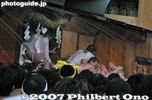
Maybe this is the Sacred Man being pulled into the window.Mar 09, 2007
|
|

Sometimes a man from the window jumps into the crowd to grab and take in the Sacred Man.Mar 09, 2007
|
|

Cloth strips (100 yen each) to ward off bad luck 厄除けの ”なおいぎれ” 初穂料 1本 100円Mar 09, 2007
|
|

When the Sacred Man enters the window, everyone cheers.Mar 09, 2007
|
|

The men are shouting "Kami-o Kami-o" (another way of pronouncing the kanji for Kami-otoko). 神男Mar 09, 2007
|
|

Giant mochi inside the Haiden hall. 大鏡餅奉納Mar 09, 2007
|
|
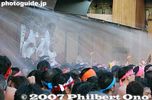
This is the small window the Sacred Man has to enter. It has a sprinkler system.Mar 09, 2007
|
|

Mar 09, 2007
|
|

TV reporter with this year's Sacred Man (Kami-otoko), Kato Norihiko 神男:加藤 典彦Mar 09, 2007
|
|
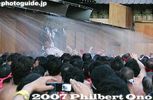
All the men want to touch the Sacred Man, believing that it will dispel bad luck.Mar 09, 2007
|
|

All the men look in the direction of the Sacred Man.Mar 09, 2007
|
|

All the men look in the direction of the Sacred Man, but few can actually see him or touch him for good luck.Mar 09, 2007
|
|

Mar 09, 2007
|
|

The festival is over.Mar 09, 2007
|
|

Men with buckets come for a refill.Mar 09, 2007
|
|

Mar 09, 2007
|
|

Mar 09, 2007
|
|

The men in the window give directions to the Sacred Man.Mar 09, 2007
|
|

Water supplyMar 09, 2007
|
|

Mar 09, 2007
|
|

They get pretty crazy, getting more water.Mar 09, 2007
|
|

The Sacred Man struggles to reach the small window.Mar 09, 2007
|
|

Konomiya Hadaka Festival, Inazawa, Aichi Pref.Mar 09, 2007
|
|

Men start to pour into the shrine.Mar 09, 2007
|
|

Stacking up the poles.Mar 09, 2007
|
|

Mar 09, 2007
|
|

It was a pretty cold day, and these men were drinking all afternoon.Mar 09, 2007
|
|

Mar 09, 2007
|
|

Splashing waterMar 09, 2007
|
|

They are waiting for the Sacred Man.Mar 09, 2007
|
|

Now they start to splash cold water on the men, and some of the spectators.Mar 09, 2007
|
|

Mar 09, 2007
|
|

Gaijin talking to gaijin. Sounded Australian. English teacher at junior high.Mar 09, 2007
|
|

Banzai cheers when an extra-large pole was brought to the shrine.Mar 09, 2007
|
|

Gaijin girls had an easy time attracting men who happily tried to converse in English and bestow cloth strips.Mar 09, 2007
|
|

Haiden Hall where the men offer their long poles. 拝殿Mar 09, 2007
|
|

Some of the men tear off strips from their handband and give them to bystanders.Mar 09, 2007
|
|

The inner path to the shrine gets more crowded.Mar 09, 2007
|
|

Haiden Hall 拝殿Mar 09, 2007
|
|

Now empty, this path will soon be filled with thousands of men in loincloths.Mar 09, 2007
|
|

After passing through this gate, the men enter the shrine grounds. Romon Gate 楼門Mar 09, 2007
|
|

Mar 09, 2007
|
|

Mar 09, 2007
|
|

Romon Gate 楼門Mar 09, 2007
|
|

Mar 09, 2007
|
|

Another toriiMar 09, 2007
|
|

Zig-zag to the shrineMar 09, 2007
|
|

Mar 09, 2007
|
|

Mar 09, 2007
|
|

Konomiya Shrine torii and the long path to the shrine is lined with a large crowd.Mar 09, 2007
|
|

Numerous groups of near-naked men (no women) proceed to the shrine all afternoon.Mar 09, 2007
|
|

Mar 09, 2007
|
|

On the straight road from Inazawa Station to Konomiya Shrine.Mar 09, 2007
|
|

Mar 09, 2007
|
|

They zig-zag along the street, and they are filled with sake.Mar 09, 2007
|
|

Raising a pole in front of Inazawa StationMar 09, 2007
|
|
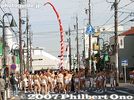
Every once in a while, they raise their pole.Mar 09, 2007
|
|

Mar 09, 2007
|
|

A group of men carry a red and white pole in front of Inazawa Station, on their way to Konomiya Shrine.Mar 09, 2007
|
|

Raising a pole in front of Inazawa StationMar 09, 2007
|
|

Konomiya Shrine holds the Hadaka (Naked or Nude) Festival in early March, or Jan. 13 of the lunar calendar. Men in loincloths parade around the streets until they reach the shrine.A Sacred Man (Shin-otoko) also appears in the shrine and the men try to touch him before he slips into the shrine's window. The festival's real name is Naoi-shinji 儺追神事 which is a rite to dispel bad luck. Photo: Nearest station is JR Inazawa Station on the Tokaido Line. 稲沢駅Mar 09, 2007
|
|

Only 10 torches are lit. Most photos show a time-lapse shot which lights up the entire hall. Tripod required though, and you need to be a press photographer.Mar 08, 2007
|
|

The torch walk ends in 20 min. Police and firemen are present.Mar 08, 2007
|
|
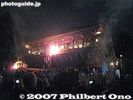
The priest runs while spinning the torch on the balcony. Also see the video at YouTube.Mar 08, 2007
|
|
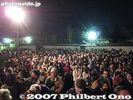
Large crowd behind us. Tripods are not allowed.Mar 08, 2007
|
|
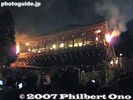
The torch is positioned at the corners. It is totally dark when the torches are lit.Mar 08, 2007
|
|
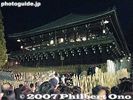
Every evening during March 1-14, Todaiji temple priests carry torches on the balcony of Nigatsu-do Hall. Sparks falling from the torches bring good health. Todaiji temple 二月堂Mar 08, 2007
|
|

Horyuji Station platformMar 07, 2007
|
|

Mar 07, 2007
|
|

Horyuji Station, under construction in Mar. 2007 法隆寺駅Mar 07, 2007
|
|

Bus stop in front of Horyuji Station. Takes you to the temple.Mar 07, 2007
|
|

Bell tower in East Precinct 東院鐘楼Mar 07, 2007
|
|

Horyuji temple, Yumedono Pavilion, National Treasure. The Nippon Budokan martial arts hall in Tokyo was designed after this pavilion. 夢殿Mar 07, 2007
|
|

Yumedono Pavilion, National Treasure dedicated to Shotoku Taishi. Built on the site of Prince Shotoku's palace. 夢殿Mar 07, 2007
|
|

Bell tower in East Precinct 東院鐘楼Mar 07, 2007
|
|

Path to Yumedono PavilionMar 07, 2007
|
|

Ticket gate to Yumedono. Admission included in the 1,000 yen ticket.Mar 07, 2007
|
|

Path to Yumedono PavilionMar 07, 2007
|
|

National TreasureMar 07, 2007
|
|

Tōdaimon Gate, National Treasure 東大門Mar 07, 2007
|
|

Chūmon Gate, National Treasure 中門Mar 07, 2007
|
|

東院鐘楼Mar 07, 2007
|
|

Signs to other templesMar 07, 2007
|
|

Corridor and Chūmon Gate 西院伽藍の廻廊Mar 07, 2007
|
|

Hall of Paintings has the Illustrated Biography of Prince Shōtoku (National Treasure), masterpiece 11th century wall painting depicting Shotoku Taishi's life episodes bordering on legend and myth since he was later revered as a Buddha by Horyuji. �Mar 07, 2007
|
|

Horyuji temple, Daikōdō Hall, National Treasure 大講堂Mar 07, 2007
|
|

Hall of Paintings. The original painting is preserved at Tokyo National Museum. Official video of the painting: https://youtu.be/sJB-03HQMNA 国宝 聖徳太子絵伝 絵殿、舎利殿Mar 07, 2007
|
|

Path to Yumedono PavilionMar 07, 2007
|
|

Chūmon Gate, National Treasure 中門Mar 07, 2007
|
|

Gate to Yumedono PavilionMar 07, 2007
|
|

Mar 07, 2007
|
|

Daiho-zoin Museum. Admission included in the 1,000 yen ticket. 大宝蔵院Mar 07, 2007
|
|

Daiho-zoin Museum 大宝蔵院Mar 07, 2007
|
|

Daikōdō Hall, National Treasure. Houses Buddha statues. 大講堂Mar 07, 2007
|
|

Mar 07, 2007
|
|

Mar 07, 2007
|
|

Kondo Main Hall, National Treasure. It has some Chinese design elements. 金堂Mar 07, 2007
|
|

Chūmon Gate and Kondo HallMar 07, 2007
|
|

Even the corridor is a National Treasure. Has about 150 wooden pillars. 西院伽藍の廻廊Mar 07, 2007
|
|

Mar 07, 2007
|
|

Mar 07, 2007
|
|

Lantern reliefMar 07, 2007
|
|

LanternMar 07, 2007
|
|

Kondo Main Hall houses 13 Buddha statues. 金堂Mar 07, 2007
|
|

Mar 07, 2007
|
|

To Daikōdō HallMar 07, 2007
|
|

Daikodo Hall and Five-Story Pagoda, National Treasures 五重塔Mar 07, 2007
|
|

Kondo Main Hall, National Treasure 金堂Mar 07, 2007
|
|

Kondo Main Hall, National Treasure 金堂Mar 07, 2007
|
|

Mar 07, 2007
|
|

Horyuji temple Kondo Main Hall, the world's oldest wooden building at 1,300 years old. National Treasure 金堂Mar 07, 2007
|
|

Kondo Main Hall, National Treasure and Horyuji's most important building. However, on January 26, 1949, much of the first floor was destroyed by accidental fire. 金堂Mar 07, 2007
|
|

Goju-no-To (Five-Story Pagoda), National Treasure, Horyuji. The size of the roof gets smaller toward the top of the structure. 五重塔 仏舎利Mar 07, 2007
|
|

Mar 07, 2007
|
|

Mar 07, 2007
|
|

You can enter or see inside the buildings, but no photography is allowed inside.Mar 07, 2007
|
|

Mar 07, 2007
|
|

Horyuji Goju-no-To (Five-Story Pagoda) National Treasure. Houses a few bones of Shakyamuni Buddha. 五重塔Mar 07, 2007
|
|

三経院 National TreasureMar 07, 2007
|
|

The Five-Story pagoda has a thick wooden pillar in the center going from the bottom to the top. Only the top part of the building is in contact with the central pillar and works to counterbalance earthquake swaying.Mar 07, 2007
|
|

Five-Story Pagoda and Kondo Hall, National Treasures 五重塔 金堂Mar 07, 2007
|
|

Mar 07, 2007
|
|

Mar 07, 2007
|
|

Horyuji temple Five-Story Pagoda and Kondo Hall, National Treasures 五重塔 金堂Mar 07, 2007
|
|

Mar 07, 2007
|
|

Sai-in Garan West Precinct 西院伽藍Mar 07, 2007
|
|

Horyuji and World Heritage Site (Japan's first) markerMar 07, 2007
|
|

Map of Horyuji. Large complex of buildings. Only two precincts are open to the public.Mar 07, 2007
|
|

Horyuji temple, Nandaimon Gate, National Treasure 南大門(国宝)Mar 07, 2007
|
|

西院伽藍Mar 07, 2007
|
|

Founded in 607 by Prince Shotoku Taishi, Horyuji is one of Japan's most famous temples, with the world's oldest wooden buildings (over 1,300 years old). Japan's first World Heritage Site.Mar 07, 2007
|
|

Also called Ikaruga-dera, the temple is the headquarters of the Shotoku-shu Buddhist Sect founded by Shotoku Taishi.Mar 07, 2007
|
|

Nandaimon Gate 南大門Mar 07, 2007
|
|

Admission charged. The 1,000 yen ticket gets you into the three major sights.Mar 07, 2007
|
|

Japan's most famous temple, with the world's oldest wooden buildings (over 1,300 years old), is also the country's first World Heritage Site. Also called Ikaruga-dera, the temple is the headquarters of the Shotoku-shu Buddhist Sect. Path toMar 07, 2007
|
|

Mar 07, 2007
|
|

Position of Oda Nobunaga's forces, the river is on the left.Mar 07, 2007
|
|

Nomura-bashi bus stop. Get off here to visit the Anegawa River battle site.Mar 07, 2007
|
|

Mar 07, 2007
|
|

Mar 07, 2007
|
|

Mar 07, 2007
|
|

Mar 07, 2007
|
|

Mar 07, 2007
|
|

Mar 07, 2007
|
|

Mar 07, 2007
|
|

Mar 07, 2007
|
|

Mt. IbukiMar 07, 2007
|
|

Mar 07, 2007
|
|

Mar 07, 2007
|
|

Mar 07, 2007
|
|

Position of the Azai clanMar 07, 2007
|
|

Mar 07, 2007
|
|

Mar 07, 2007
|
|

Mar 07, 2007
|
|

Mar 07, 2007
|
|

Mar 07, 2007
|
|

Mar 07, 2007
|
|

Position of the Azai clanMar 07, 2007
|
|

Mar 07, 2007
|
|

Fallen tree on riverbedMar 07, 2007
|
|
| 71466 files on 284 page(s) |
 |
 |
242 |  |
 |
|